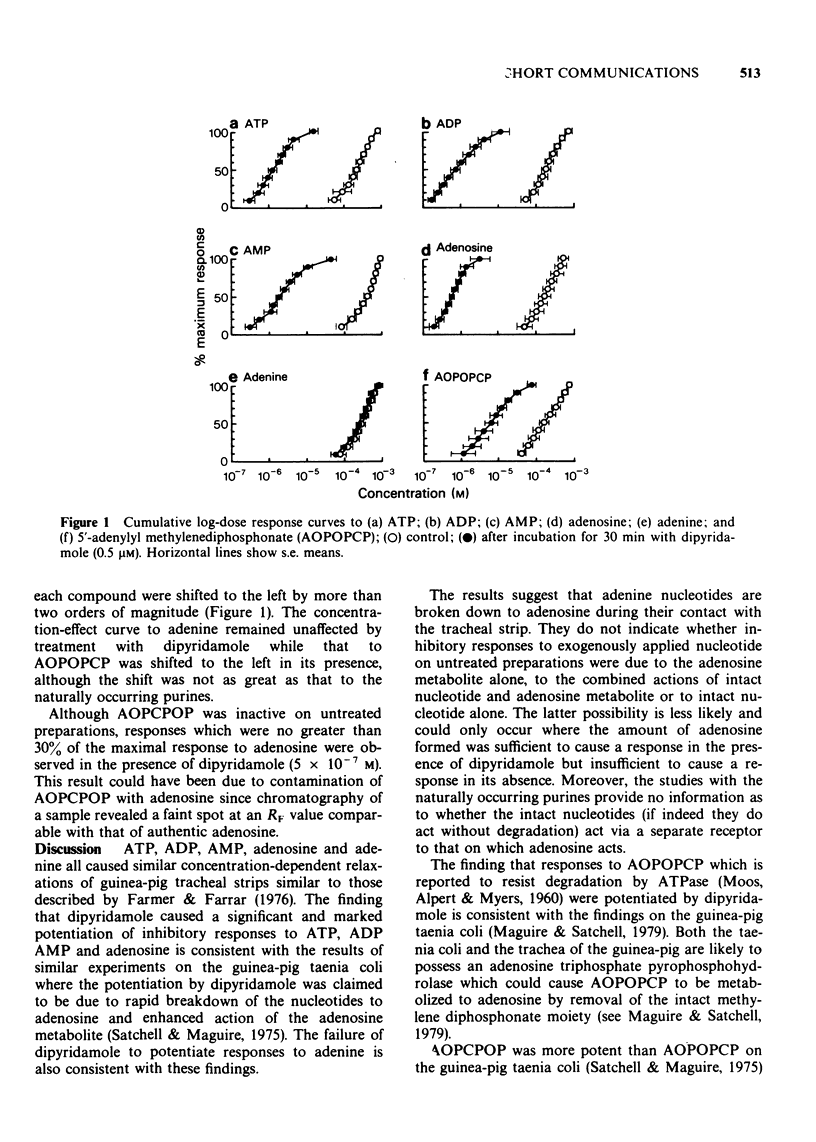Abstract
In guinea-pig trachea adenosine 5'-triphosphate (ATP), adenosine 5'-diphosphate (ADP), adenosine 5'-phosphate (AMP), adenosine and adenine were similarly potent in causing relaxation of the smooth muscle. This is in contrast to gut where ATP and ADP are 30 times more potent than adenosine. Studies with dipyridamole suggest that in trachea, as in gut, nucleotides are rapidly metabolized to adenosine. A polyphosphate modified analogue of ATP, the alpha,beta-methylene isostere, which resists degradation to adenosine was inactive in trachea although it is a potent relaxant in gut. This result may suggest that the intact ATP molecule is also inactive in the tracheal preparation: i.e. ATP acts only via its adenosine metabolite implying that receptors for adenosine but not ATP are present in the tissue.
Full text
PDF


Selected References
These references are in PubMed. This may not be the complete list of references from this article.
- Coleman R. A. Effects of some purine derivatives on the guinea-pig trachea and their interaction with drugs that block adenosine uptake. Br J Pharmacol. 1976 May;57(1):51–57. doi: 10.1111/j.1476-5381.1976.tb07655.x. [DOI] [PMC free article] [PubMed] [Google Scholar]
- Coleman R. A., Levy G. P. A non-adrenergic inhibitory nervous pathway in guinea-pig trachea. Br J Pharmacol. 1974 Oct;52(2):167–174. doi: 10.1111/j.1476-5381.1974.tb09697.x. [DOI] [PMC free article] [PubMed] [Google Scholar]
- Farmer J. B., Farrar D. G. Pharmacological studies with adenine, adenosine and some phosphorylated derivatives on guinea-pig tracheal muscle. J Pharm Pharmacol. 1976 Oct;28(10):748–752. doi: 10.1111/j.2042-7158.1976.tb04040.x. [DOI] [PubMed] [Google Scholar]
- MOOS C., ALPERT N. R., MYERS T. C. Effects of a phosphonic acid analog of adenosine triphosphate on actomyosin systems. Arch Biochem Biophys. 1960 Jun;88:183–192. doi: 10.1016/0003-9861(60)90220-4. [DOI] [PubMed] [Google Scholar]
- Maguire M. H., Satchell D. G. The contribution of adenosine to the inhibitory actions of adenine nucleotides on the guinea-pig taenia coli: studies with phosphate-modified adenine nucleotide analogs and dipyridamole. J Pharmacol Exp Ther. 1979 Dec;211(3):626–631. [PubMed] [Google Scholar]
- Satchell D. G., Burnstock G. Comparison of the inhibitory effects on the guinea-pig taenia coli of adenine nucleotides and adenosine in the presence and absence of dipyridamole. Eur J Pharmacol. 1975 Jun-Jul;32(02):324–328. doi: 10.1016/0014-2999(75)90299-x. [DOI] [PubMed] [Google Scholar]
- Satchell D. G., Lynch A., Bourke P. M., Burnstock G. Potentiation of the effects of exogenously applied ATP and purinergic nerve stimulation on the guinea-pig taenia coli by dipyridamole and hexobendine. Eur J Pharmacol. 1972 Sep;19(3):343–350. doi: 10.1016/0014-2999(72)90100-8. [DOI] [PubMed] [Google Scholar]
- Satchell D. G., Maguire M. H. Inhibitory effects of adenine nucleotide analogs on the isolated guinea-pig taenia coli. J Pharmacol Exp Ther. 1975 Dec;195(3):540–548. [PubMed] [Google Scholar]


